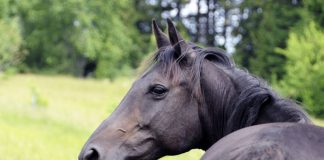Q: My horse has been diagnosed with severe ringbone. I know he’ll never be ridden again, but I want to keep him pasture sound. Is there any medicine to help keep him comfortable? I don’t want to keep him on Bute because I’m afraid it’s hurting his stomach, but when I don’t give him anything he limps and shuffles and lies down a lot. What can I do for him?
To be more descriptive, this condition is usually classified as high ringbone or low ringbone. High ringbone is located at the end of P1 and start of P2 and low ringbone is located at the end of P2 and start of P3. Since ringbone and DJD often go hand in hand, their causes are similar: osteochondritis desicans (OCD) and osteochondrosis in younger horses has been linked to both ringbone and DJD, as well as repetitive trauma in older horses, and conformational defects such as extremely upright pasterns.
Chronic pain management in horses is a challenging concept in veterinary medicine. Phenylbutazone (BFute), the most common NSAID (non-steroidal anti-inflammatory drug) given for lameness in horses can cause stomach ulcerations. Do you know for sure that Bute is upsetting your horse’s digestive tract? Signs of gastric ulcers include decreased appetite, weight loss, teeth grinding, and mild colic. You may try administering a gastric protectant such as GastroGuard with the Bute to help counteract this side effect, or work with your vet to find a lower dose of Bute that your horse tolerates better.
There is another relatively new NSAID now on the market for lameness that claims to be gentler on the stomach, with the trade name Equioxx. Sometimes one class of NSAIDs is better tolerated than another in an individual animal, so this is something else you could try as a substitute for Bute. There is also a topical NSAID called Surpass that can be applied directly to the skin of the affected area and this may be of some benefit to your horse. Injectable joint supplements such as the intramuscular Adequan or the IV injection Legend may be of some benefit as well.
Without specifics on the location and exact severity of the ringbone, it is difficult to recommend specific things to try, but other than oral NSAIDs for pain control, you may further want to discuss more invasive options such as joint injections of steroids and hyaluronic acid or even arthrodesis, which is the surgical fusing of severely arthritic joints. The movement of bone on bone causes joint pain, so when two bones are fused together thereby eliminating movement, this can greatly reduce the pain. Obviously, this is a permanent surgical procedure.
Other management options include ensuring your horse is not overweight, as extra weight merely increases the stress on already damaged joints, and ensuring that your horse’s stall is bedded down as deeply as possible, or consider installing rubber mats with a certain amount of cushion. Depending on your horse’s conformation, corrective trimming and shoeing may help as well.
If you are unable to devise a pain management strategy with your vet that works for your horse, please consider your horse’s quality of life. If this chronic severe pain cannot be controlled by well-tolerated oral medication and if any further invasive techniques are not an option, euthanasia may be the only humane choice. Please discuss this further with your veterinarian.
— Anna O’Brien
Ask your questions on the HorseChannel.com Forums >>
See more Expert Q&As >>
Submit your Ask the Expert question >>







Arthritic joints in human need movement and excerise to feel better, would not this be the same for horses??
One thing the article didn’t mention is the use of a few products that I’ve personally had excellent results using. I have dealt with geriatric horses and rescue horses for almost two decades, and there are more options for helping severely arthritic horses than mentioned here. One product I really like (and which was twice named the Horse Journal product of the year) is BL-Pellets, and the liquid version BL-Solution. BL stands for “bute-less”. It’s a powerful anti-inflammatory and painkiller that doesn’t use NSAIDs, and while it’s not as effective as Bute in all cases, it’s got no side effects that I’m aware of. Another great product is MSM. MSM is a naturally-occurring and bio-available sulfur that reduces inflammation and associated pain – it’s also very affordable and has other benefits throughout the body. Thirdly, I highly recommend talking to your vet about the use of Adequan injections. Adequan is a concentrated, IM medication containing HA. It improves joint function and reduces joint inflammation, for comfort and mobility. It’s around $45 a dose, but a dose lasts an entire month, after the initial loading dose, but in my experience, the loading dose is optional.
Scary